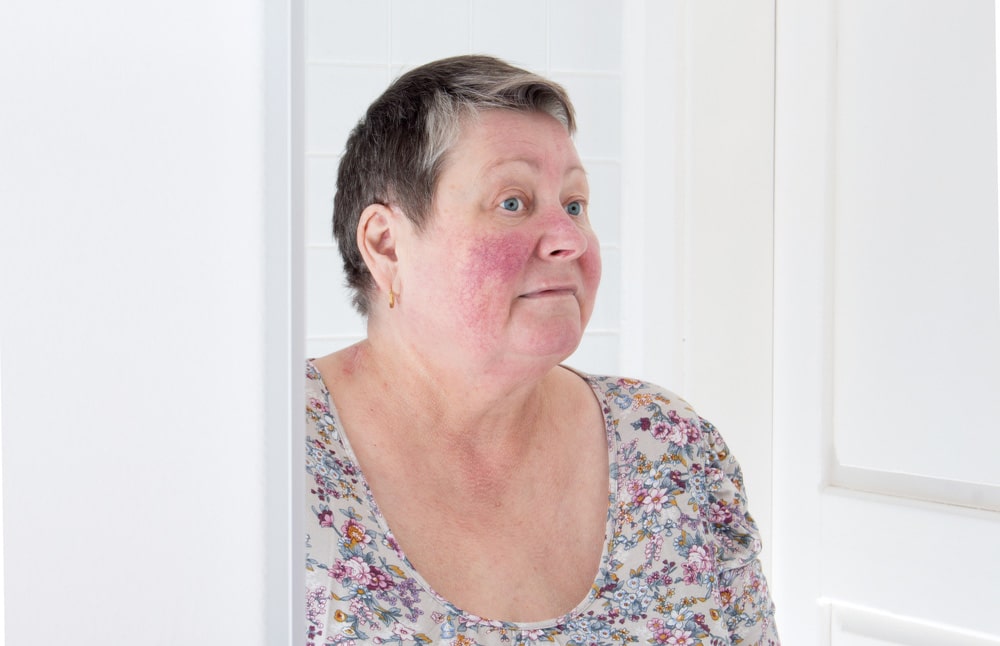[av_heading heading=’Is Rosacea Connected to Other Health Problems?’ tag=’h1′ style=’blockquote modern-quote’ size=” subheading_active=” subheading_size=’15’ padding=’10’ color=” custom_font=” admin_preview_bg=”][/av_heading]
[av_textblock size=” font_color=” color=” admin_preview_bg=”]
Rosacea has typically been categorized as a disease that disrupts one’s quality of life, but not a disease that is a life-threatening condition. However, more and more research is connecting rosacea to other diseases, leading many dermatologists and other medical professionals worried about the millions with rosacea who aren’t receiving treatment.
“… a growing number of studies have found associations between rosacea and increased risk for a variety of potentially serious systemic disorders – from cardiovascular disease to certain cancers and gastrointestinal disease,” said Dr. Sewon Kang, chairman of dermatology at Johns Hopkins School of Medicine.
Of the 16 million Americans with rosacea, only a small percentage receive treatment.
A study from Wake Forest School of Medicine found that 82 percent of people with rosacea are not treated. That is about 13 million people.
Those who are suffering from symptoms of rosacea should see a doctor for a diagnosis, because your risk for other illnesses may be increased. Catching chronic illness early is vital for the best outcomes.
[/av_textblock]
[av_hr class=’custom’ height=’50’ shadow=’no-shadow’ position=’center’ custom_border=’av-border-thin’ custom_width=’550px’ custom_border_color=’#70be3c’ custom_margin_top=’10px’ custom_margin_bottom=’10px’ icon_select=’no’ custom_icon_color=” icon=’ue808′ font=’entypo-fontello’ admin_preview_bg=”]
[av_one_third first min_height=’av-equal-height-column’ vertical_alignment=’av-align-middle’ space=” margin=’0px’ margin_sync=’true’ padding=’0px’ padding_sync=’true’ border=” border_color=” radius=’0px’ radius_sync=’true’ background_color=” src=” attachment=” attachment_size=” background_position=’top left’ background_repeat=’no-repeat’ animation=” mobile_display=”]
[av_heading heading=’Studies Connecting Rosacea and Other Diseases’ tag=’h2′ style=’blockquote modern-quote modern-centered’ size=” subheading_active=” subheading_size=’15’ padding=’10’ color=” custom_font=” admin_preview_bg=”][/av_heading]
[/av_one_third]
[av_two_third min_height=” vertical_alignment=” space=” custom_margin=” margin=’0px’ padding=’0px’ border=” border_color=” radius=’0px’ background_color=” src=” background_position=’top left’ background_repeat=’no-repeat’ animation=” mobile_display=”]
[av_iconlist position=’left’ iconlist_styling=’av-iconlist-small’ custom_title_size=’18’ custom_content_size=” font_color=” custom_title=” custom_content=” color=” custom_bg=” custom_font=” custom_border=” admin_preview_bg=”]
[av_iconlist_item title=’Researchers find significant associations between rosacea and inflammatory bowel disease (IBD)’ link=” linktarget=” linkelement=” icon=’ue879′ font=’entypo-fontello’]
United Kingdom, South Korea
[/av_iconlist_item]
[av_iconlist_item title=’Researchers find a greater risk of high cholesterol, coronary artery disease, high blood pressure in patients with rosacea.’ link=” linktarget=” linkelement=” icon=’ue879′ font=’entypo-fontello’]
Taiwan
[/av_iconlist_item]
[av_iconlist_item title=’Researchers find that women with rosacea were 1.59 times more likely to have thyroid cancer, and 1.5 times as likely to have basal cell carcinoma.’ link=” linktarget=” linkelement=” icon=’ue879′ font=’entypo-fontello’]
Nurses Health Study II
[/av_iconlist_item]
[/av_iconlist]
[/av_two_third]
[av_hr class=’custom’ height=’50’ shadow=’no-shadow’ position=’center’ custom_border=’av-border-thin’ custom_width=’550px’ custom_border_color=’#70be3c’ custom_margin_top=’10px’ custom_margin_bottom=’10px’ icon_select=’no’ custom_icon_color=” icon=’ue808′ font=’entypo-fontello’ admin_preview_bg=”]
[av_textblock size=” font_color=” color=” admin_preview_bg=”]
Other studies have drawn connections between rosacea and allergies, respiratory diseases, gastroesophageal reflux disease (GERD), diabetes, urogenital diseases, female hormone imbalance, Parkinson’s disease, Alzheimer’s disease and glioma, a form of brain cancer.
Still, researchers don’t know enough about the disease to say rosacea causes any of these other disease. In fact, there is a lot left to learn about rosacea as a disease.
Those with rosacea should receive regular general health examinations to check for other health conditions.
Rosacea generally first appears after age 30. It may resemble a sunburn or blush that comes on inexplicably. The redness then fades, but flare ups continue to occur from time to time, lasting longer each time. Small blood vessels may begin to appear on the face., along with bumps or pimples. Eyes may become watery.
If you’re experiencing these symptoms, go see a dermatologist for a diagnosis, and see your primary care doctor for a complete medical checkup. This is an important precaution to take as researchers learn more about how rosacea is connected to other diseases.
[/av_textblock]



